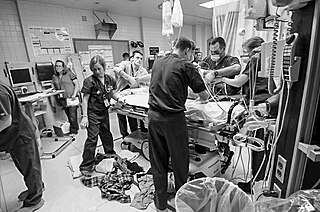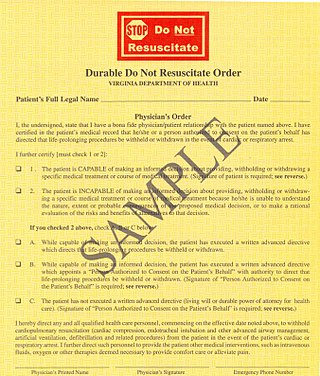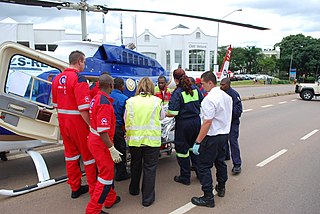Related Research Articles

Emergency medicine is the medical speciality concerned with the care of illnesses or injuries requiring immediate medical attention. Emergency medicine physicians specialize in providing care for unscheduled and undifferentiated patients of all ages. As first-line providers, in coordination with emergency medical services, they are primarily responsible for initiating resuscitation and stabilization and performing the initial investigations and interventions necessary to diagnose and treat illnesses or injuries in the acute phase. Emergency medical physicians generally practice in hospital emergency departments, pre-hospital settings via emergency medical services, and intensive care units. Still, they may also work in primary care settings such as urgent care clinics.

A do-not-resuscitate order (DNR), also known as Do Not Attempt Resuscitation (DNAR), Do Not Attempt Cardiopulmonary Resuscitation (DNACPR), no code or allow natural death, is a medical order, written or oral depending on the jurisdiction, indicating that a person should not receive cardiopulmonary resuscitation (CPR) if that person's heart stops beating. Sometimes these decisions and the relevant documents also encompass decisions around other critical or life-prolonging medical interventions. The legal status and processes surrounding DNR orders vary in different polities. Most commonly, the order is placed by a physician based on a combination of medical judgement and patient involvement.

Life support comprises the treatments and techniques performed in an emergency in order to support life after the failure of one or more vital organs. Healthcare providers and emergency medical technicians are generally certified to perform basic and advanced life support procedures; however, basic life support is sometimes provided at the scene of an emergency by family members or bystanders before emergency services arrive. In the case of cardiac injuries, cardiopulmonary resuscitation is initiated by bystanders or family members 25% of the time. Basic life support techniques, such as performing CPR on a victim of cardiac arrest, can double or even triple that patient's chance of survival. Other types of basic life support include relief from choking, staunching of bleeding by direct compression and elevation above the heart, first aid, and the use of an automated external defibrillator.
A trauma center, or trauma centre, is a hospital equipped and staffed to provide care for patients suffering from major traumatic injuries such as falls, motor vehicle collisions, or gunshot wounds. A trauma center may also refer to an emergency department without the presence of specialized services to care for victims of major trauma.

Intensive care medicine, also called critical care medicine, is a medical specialty that deals with seriously or critically ill patients who have, are at risk of, or are recovering from conditions that may be life-threatening. It includes providing life support, invasive monitoring techniques, resuscitation, and end-of-life care. Doctors in this specialty are often called intensive care physicians, critical care physicians, or intensivists.

Peter Safar was an Austrian anesthesiologist of Czech descent. He is credited with pioneering cardiopulmonary resuscitation (CPR).

Extracorporeal membrane oxygenation (ECMO), is a form of extracorporeal life support, providing prolonged cardiac and respiratory support to persons whose heart and lungs are unable to provide an adequate amount of oxygen, gas exchange or blood supply (perfusion) to sustain life. The technology for ECMO is largely derived from cardiopulmonary bypass, which provides shorter-term support with arrested native circulation. The device used is a membrane oxygenator, also known as an artificial lung.

Major trauma is any injury that has the potential to cause prolonged disability or death. There are many causes of major trauma, blunt and penetrating, including falls, motor vehicle collisions, stabbing wounds, and gunshot wounds. Depending on the severity of injury, quickness of management, and transportation to an appropriate medical facility may be necessary to prevent loss of life or limb. The initial assessment is critical, and involves a physical evaluation and also may include the use of imaging tools to determine the types of injuries accurately and to formulate a course of treatment.

Artificial ventilation or respiration is when a machine assists in a metabolic process to exchange gases in the body by pulmonary ventilation, external respiration, and internal respiration. A machine called a ventilator provides the person air manually by moving air in and out of the lungs when an individual is unable to breathe on their own. The ventilator prevents the accumulation of carbon dioxide so that the lungs don't collapse due to the low pressure. The use of artificial ventilation can be traced back to the seventeenth century. There are three ways of exchanging gases in the body: manual methods, mechanical ventilation, and neurostimulation.
WebMD is an American corporation which publishes online news and information about human health and well-being. The WebMD website also includes information about drugs and is an important healthcare information website and the most popular consumer-oriented health site.

An emergency physician is a physician who works in an emergency department to care for ill patients. The emergency physician specializes in advanced cardiac life support, resuscitation, trauma care such as fractures and soft tissue injuries, and management of other life-threatening situations.

R Adams Cowley Shock Trauma Center is a free-standing trauma hospital in Baltimore, Maryland and is part of the University of Maryland Medical Center. It was the first facility in the world to treat shock. Shock Trauma was founded by R Adams Cowley, considered the father and major innovator of trauma medicine.

The Center for Emergency Medicine of Western Pennsylvania is a multi-hospital consortium based in Pittsburgh, Pennsylvania. It is claimed to be one of the world's premiere centers of Emergency Medicine and EMS development. It currently ranks sixth for residencies in emergency medicine by reputation.
A flight paramedic is a paramedic who provides care to sick and injured patients in an aeromedical environment. Typically a flight paramedic works with a registered nurse, physician, respiratory therapist, or another paramedic. Flight paramedics must have an advanced medical knowledge along with years of clinical experience. Flight paramedics in the United States usually hold certifications such as the FP-C or the CCP-C, while in countries like the United Kingdom, they are typically required to hold a postgraduate certificate in critical care as a minimum, with many holding a master's degree in advanced practice or aeromedical critical care.

Emergency medical services in South Africa are a public/private system aimed at the provision of emergency ambulance service, including emergency care and transportation to hospital.
The following outline is provided as an overview of and topical guide to emergency medicine:

Seth Christopher Collings Hawkins is an American emergency physician, writer, anthropologist, and organizational innovator. He has made notable contributions to the fields of wilderness medicine, Emergency Medical Services (EMS), and medical humanities. His work has particularly specialized in EMS and wilderness medicine in the southeastern United States, where he is the founder of the Appalachian Center for Wilderness Medicine, the Appalachian Mountain Rescue Team, and the Carolina Wilderness EMS Externship.

Kimball C. Atwood IV is an American medical doctor and researcher from Newton, Massachusetts. He is retired as an assistant clinical professor at Tufts University School of Medicine and anesthesiologist at Newton-Wellesley Hospital.
The treatment and management of COVID-19 combines both supportive care, which includes treatment to relieve symptoms, fluid therapy, oxygen support as needed, and a growing list of approved medications. Highly effective vaccines have reduced mortality related to SARS-CoV-2; however, for those awaiting vaccination, as well as for the estimated millions of immunocompromised persons who are unlikely to respond robustly to vaccination, treatment remains important. Some people may experience persistent symptoms or disability after recovery from the infection, known as long COVID, but there is still limited information on the best management and rehabilitation for this condition.

Brendan G. Carr, MD, MA, MS is an American physician and educator. He is Chief Executive Officer of the Mount Sinai Health System as of 2024, and Professor and Endowed System Chair of Emergency Medicine at the Icahn School of Medicine at Mount Sinai and the Mount Sinai Health System.
References
- ↑ "What it's like in critical care medicine". American Medical Association. Archived from the original on 14 March 2020. Retrieved 13 March 2020.
The online resource students interested in pulmonary and critical care medicine should follow…EMCrit, a blog about emergency medicine and critical care.
- ↑ Simpson, Elizabeth (17 May 2017). "Vitamin C as sepsis treatment: Should doctors wait for proof, or treat dying patients now?". The Virginian-Pilot. Archived from the original on 24 January 2020. Retrieved 13 March 2020.
- ↑ Christopher M. Tedeschi MD MA (28 July 2017). "Notes From a Most Unusual Critical Care Conference". Medscape . WebMD. Archived from the original on 14 August 2019. Retrieved 13 March 2020.
FOAMed has its roots in a loosely organized but influential community of bloggers and podcasters. EmCrit, arguably the most popular EM–critical care-focused site, boasts more than 34,000 Twitter followers.
- 1 2 "Department of Emergency Medicine". Renaissance School of Medicine. Archived from the original on 14 March 2020. Retrieved 13 March 2020.
- ↑ "Faculty". Reanimate Conference. Retrieved 2020-08-28.
- ↑ "CME for Critical Care". EMCrit/EB Medicine. 22 December 2014. Archived from the original on 3 April 2019. Retrieved 13 March 2020.
- ↑ "The Resuscitation Crisis Manual". Leeuwin Press. Archived from the original on 16 June 2019. Retrieved 13 March 2020.
- ↑ "The University of Vermont Medical Center". University of Vermont Medical Center. Archived from the original on 14 March 2020. Retrieved 12 March 2020.
- ↑ Farkas, Josh (March 2020). "COVID19". The Internet Book of Critical Care (digital) (Reference manual). USA: EMCrit. Archived from the original on 11 March 2020. Retrieved 13 March 2020.
- ↑ "A List of Resources for COVID 19: Scientific and medical data". Princeton University Library. 13 March 2020. Archived from the original on 14 March 2020. Retrieved 13 March 2020.
- ↑ "COVID19 - Resources for Health Care Professionals". Penn Libraries. 11 March 2020. Archived from the original on 14 March 2020. Retrieved 13 March 2020.